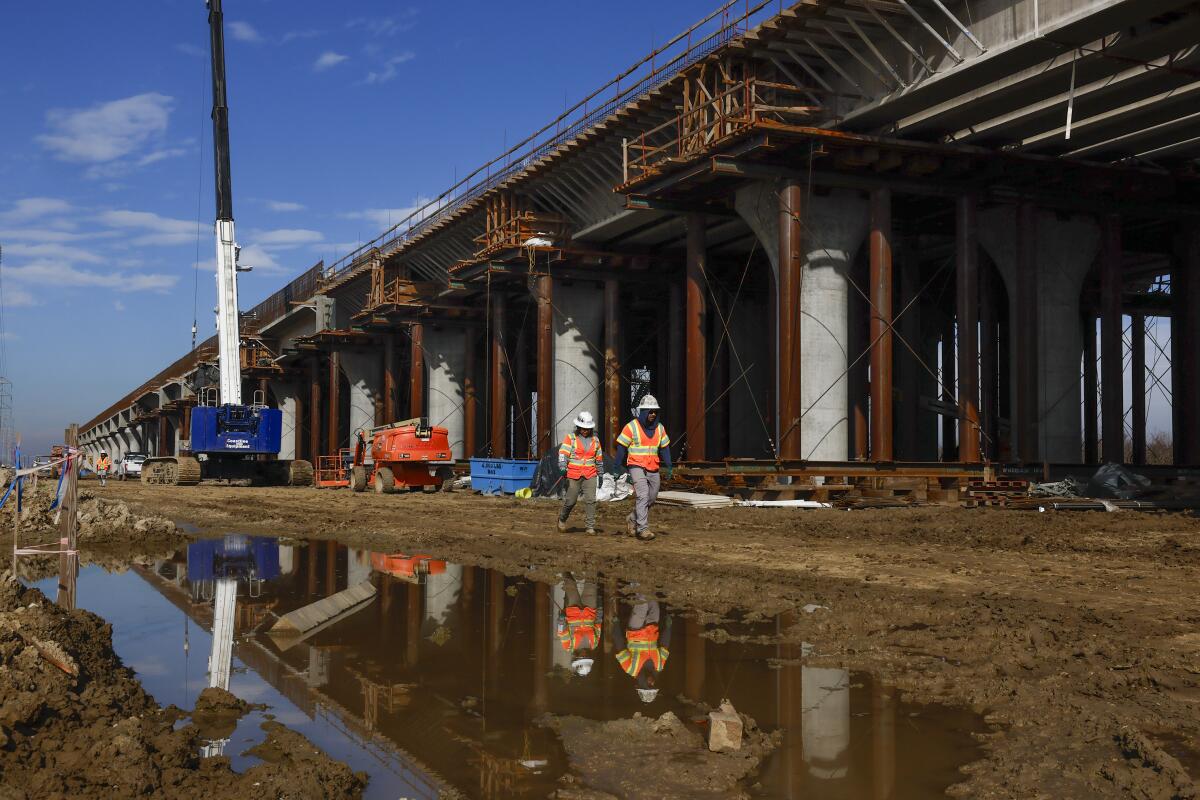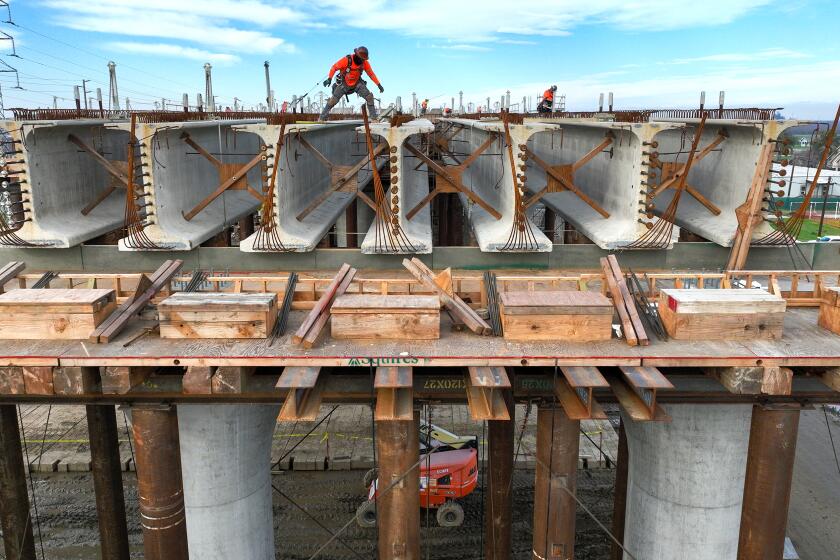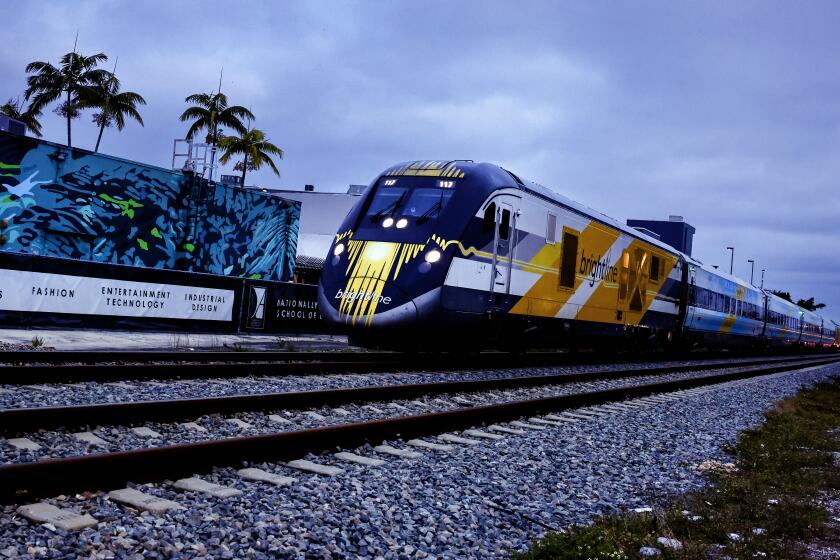Despite some progress, state’s high-speed rail is $100 billion short and many years from reality

- Share via
California’s high-speed rail train could feature an indoor play area for children and seating options that would allow people to meet as a group or cocoon in a reading nook. Recently released drawings of the imagined interior, station platforms and a video walk-through of a model train car offered a glimpse into the future of the transit system and its promise to transform the state.
But how — and if — it will ever live up to that promise to connect Los Angeles to San Francisco by train in less than three hours still remains unknown. While some progress has been made in the last 15 years, the timeline for completion has moved back by more than a decade and cost estimates have grown by the billions.
Transit experts and state policy advisers have continued to question how the lofty project will be paid for as the proposed cost has increased without guaranteed funding sources. Projected ridership has also dipped since the pandemic.
“Schedules are stretching out, demand estimates have fallen and financing is inadequate and unstable,” said high-speed rail peer-review group chair Louis Thompson at a recent state legislative hearing. The state-appointed panel advises the California High-Speed Rail Authority.
Rail Authority Chief Executive Brian Kelly, who plans to step down this year, and other rail officials have also acknowledged the questionable funding of a rail system with less than a quarter of its length under construction three years after the the first phase was supposed to be completed.
Here’s where things stand:
When will the train start running and where will it go?
Voters first approved a high-speed rail proposal in 2008 that would connect Los Angeles to San Francisco by 2020. That end date has changed considerably over time.
There is no set timeline for when anyone will be able to ride the entire 494-stretch from Anaheim to San Francisco.
The current focus centers on the Central Valley, where officials estimate the 171-mile line from Merced to Bakersfield will be finished between 2030 and 2033.
For Central Valley residents, high-speed rail will be a reality in just a few years. Construction of the rail line is transforming local economies, and residents say they see a broad new horizon when it comes to accessing jobs, healthcare and education.
There are currently 119 miles under construction stretching from Madera to Shafter. An environmental review cleared the expansion to Merced and Bakersfield, but the authority has not yet fully secured funding to do so.
While construction has been a boon for the area that was hard-hit by the Great Recession when the rail system was passed, bringing in more than 12,000 jobs to the Central Valley, the train has been out of sight for much of the state.
“We’re starting in the most underpopulated portion of the route,” said Ethan Elkind, director of the climate program at UC Berkeley Law’s Center for Law, Energy and the Environment. “The voters and the taxpayers in the [more] populated areas see no benefit from the system.”
There’s economic and social advantages for connecting areas in the Central Valley to “thriving coastal economies because we have a very unequal society in California,” Elkind said. But no one knows when that will definitively happen.
Officials expect that the 463-mile stretch between Los Angeles and San Francisco will be environmentally cleared by May, pending approval of a key section between Palmdale and Burbank. Funding for that additional construction has not been locked down.
The high-speed rail peer-review group has recommended the Legislature commission an “independent review of the economic and financial justification for the project” before “recommitting” to the first phase.
How much will the project cost?
Officials estimate it could cost about $35 billion to finish the first line from Bakersfield to Merced and roughly $100 billion more to complete the route from Los Angeles to San Francisco — about $100 billion more than what was originally proposed years ago. And the source of most funds is unclear.
High-speed rail development relies on state and federal funding and California’s cap-and-trade incentive, which is set to expire in 2030. The authority hopes to secure private investments in the future, according to its most recent business plan, but currently uses none.
The White House is betting that Florida’s Brightline can build a successful high-speed rail line. But the Las Vegas-to-Southern California route has challenges.
The outcome of the November election could have an effect on future funding.
“We want a federal partner that celebrates California and that celebrates what high-speed rail not only brings to our state, but really, to our nation,” state assembly Transportation Chair Lori D. Wilson (D-Suisun City) said.
The Trump administration previously tried to pull back funding for the project, while the Biden administration has been more supportive. It recently awarded the state more than $3 billion for the project, which will go toward the completion of the Central Valley line.
The authority is still about $7 billion short for what’s needed to finish the Central Valley line, in addition to the tens of billions of dollars needed to fund the rest of the route.
“There is no source of that money right now,” Thompson told The Times. “If and when they reach the point where they want to get out of the Central Valley, then the state itself is going to have to find a lot more money.”
Once the first line is complete, a second phase is supposed to connect Merced to Sacramento and Los Angeles to San Diego, expanding the line to about 800 miles.
Why the delay?
Transit experts have said the mega-project launched before it was ready to. As Thompson told the Legislature in 2019, “we got the cart before the horse.”
Kelly acknowledged the misstep at a recent hearing.
“It got federal monies to start in a specific location and those dollars had to be spent under an unrealistic timeline,” he said. “The authority wanted to advance work to keep the federal dollars which was understandable, but in so doing, it got into construction before some of the pre-construction activities were done.”
The rail authority essentially tried to learn how to develop the country’s first high-speed rail system in real time.
“They were hiring consultants, they were getting sued, they were spending a lot of money and nothing was getting built,” Elkind said.
Environmental reviews and lawsuits over the authority’s plans to disrupt housing complexes and developments have caused other setbacks. So has political jockeying and the project’s need for buy-in from voters across the state’s 58 counties. Over the years, local leaders have opined about where the train should go and which communities should directly benefit, leading to shifts in strategy that have prolonged the process.
Instead of taking a direct route up Interstate 5, for example, the train’s route veered through the eastern cities of the Central Valley to get support from county leaders and the federal government.
“That takes the route out of the most direct path and opens up a lot of land-use controversies, a lot of expense and hassle,” Elkind said.

How has the project affected communities?
The project has posed benefits and challenges for some communities. Thousands of construction jobs have been created in the Central Valley and some areas have seen a rise in businesses and redeveloped downtown areas in anticipation of the future rail.
“It becomes an equalizer,” Merced’s deputy city manager Frank Quintero said about the system’s ability to connect the Central Valley with other metropolitan areas. “Now we’re going to be as desirable as the Bay Area as a whole and Southern California.”
Construction and the possibility of construction has also brought some issues. In downtown Fresno, for example, a thoroughfare road has been closed for eight years. In Bakersfield, business owners have sought clarity about when they’ll have to move, and where they will relocate to, making planning difficult.
There are some logistical questions that have yet to be answered too, including how people will ultimately get to future stations in areas that have limited public transit.
Will the high-speed rail work with the Brightline rail?
The federal government has awarded a $3-billion grant to private railroad Brightline for the development of a high-speed rail line between Rancho Cucamonga and Las Vegas. It is a much more simple venture, not crossing though cities and farmlands, running down the wide median of Interstate 15 in the desert. The project is aiming to open by the 2028 Los Angeles Olympics.
Kelly recently said that the hope is that the state’s high-speed rail will eventually integrate with the Brightline rail, potentially filling a transit gap between stations.
More to Read
Sign up for Essential California
The most important California stories and recommendations in your inbox every morning.
You may occasionally receive promotional content from the Los Angeles Times.












